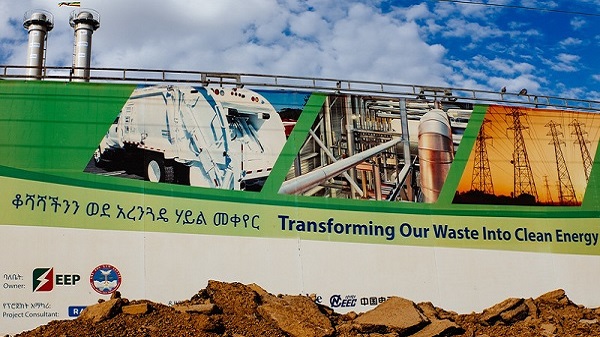
Reppie Waste-to-Energy plant burns rubbish and uses the heat to boil water. The steam then drives two turbine generators. Modern gas treatment technology reduces the release of toxins during the process.
By Alex Gray (World Economic Forum)
Africa is the world’s fastest-urbanizing continent. But while city life has helped lift millions out of poverty, the rapid transformation has created a new problem: mountains of urban waste. Now an Ethiopian entrepreneur is tackling the crisis with Africa’s first waste-to-energy plant, which reduces noxious and dangerous landfill while powering urban homes.
Samuel Alemayehu, a Stanford engineer, former Silicon Valley entrepreneur and World Economic Forum Young Global Leader, says the plant will supply 30% of Addis Ababa’s household energy needs and incinerate roughly 80% of its rubbish. That’s 1,400 tons of waste every day. Samuel oversees the $120 million project as a co-founder of Cambridge Industries, which together with its Chinese JV partner CNEEC, has joined the Ethiopian government and a consortium of international companies to transform the city’s approach to waste.
“We turn one of Africa’s most challenging social problems, the management of waste, into a source of new wealth”, Cambridge Industries says.
Until now, Addis Ababa’s rubbish was dumped on a vast, ever-growing landfill site that covers an area the size of 36 football pitches. Leaking waste from the site has polluted nearby rivers, while the waste itself produces methane, a powerful greenhouse gas. The landfill is also very unstable. In 2017, a landslide killed 114 people. It became a national tragedy.
At the same time, Ethiopia’s power supply is failing to keep up with breakneck economic growth of more than 10% every year. The Reppie Waste-to-Energy plant, which meets EU emissions standards, is designed to solve both problems.
The plant burns the capital’s rubbish at a temperature of up to 1,800 degrees Celsius and converts it into 185 million KW hours of electricity per annum. Reppie is part of Ethiopia’s broader plan to boost living standards while limiting its emissions, a strategy it refers to as building a “climate-resilient green economy”.
This includes a goal to invest $2 billion annually in expanding the country’s renewable energy generation through 2030, double the current annual spending of $1 billion. The planned financing will include private investment, climate funds and clean energy sales to neighboring countries.
Waste incineration is already common in Europe, where nearly a quarter of waste is burnt. But in Africa, so far the only ways to dispose of rubbish have been to pile it up, bury it or dump it in rivers and lagoons. The sites attract vermin and are ideal breeding grounds for mosquitoes, contributing to the spread of diseases from malaria to yellow fever.
The new plant burns rubbish and uses the heat to boil water. The steam then drives two turbine generators. Modern gas treatment technology reduces the release of toxins during the process.
“We hope that Reppie will serve as a model for other countries in the region, and around the world”, says Zerubabel Getachew, Ethiopia’s deputy permanent representative to the United Nations in Nairobi.
Samuel, a World Economic Forum Young Global Leader, is already working on expanding the reach of renewables on the continent. He has plans to construct similar waste-to-energy plants in Uganda, Kenya, Cameroon, Senegal and Djibouti.
“African cities have seen explosive growth in the past three decades and have outgrown the infrastructures planned for them”, says Samuel.
“We believe these plants will create for African megacities a modern, multipurpose infrastructure, using new technology, which will enable them simultaneously to dispose of waste, generate sustainable energy, clean and reuse water, recycle valuable resources, generate industrial grade steam for use by other businesses and, most importantly, do all this in one facility located safely within city limits.”
Samuel Alemayehu is a member of the World Economic Forum’s 2018 class of Young Global Leaders. Find out more here.
Source: World Economic Forum
